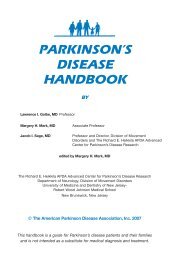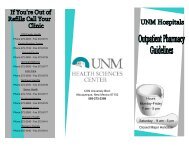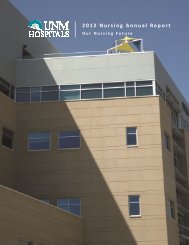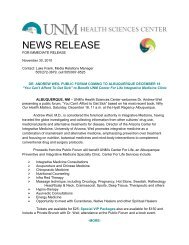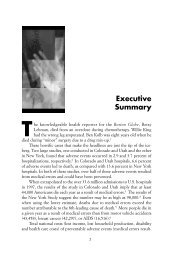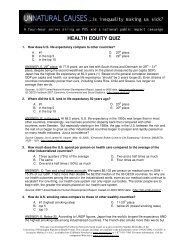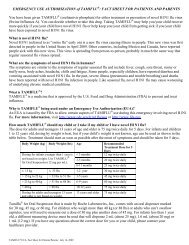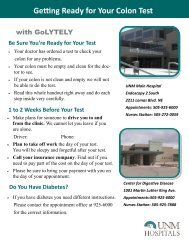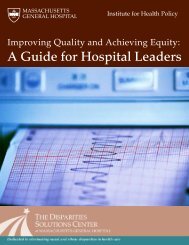Advanced Effective Communication, Cultural Competence, and ...
Advanced Effective Communication, Cultural Competence, and ...
Advanced Effective Communication, Cultural Competence, and ...
You also want an ePaper? Increase the reach of your titles
YUMPU automatically turns print PDFs into web optimized ePapers that Google loves.
A Roadmap for Hospitals<br />
Appendix B: Current Joint Commission Requirements<br />
Joint Commission HR Requirements<br />
HR.01.02.01 The hospital defines staff<br />
qualifications.<br />
EP 1 The hospital defines staff qualifications specific to<br />
their job responsibilities.<br />
HR.01.04.01 The hospital provides orientation<br />
to staff.<br />
EP 3 The hospital orients staff on the following: Relevant<br />
hospitalwide <strong>and</strong> unit-specific policies <strong>and</strong><br />
procedures. Completion of this orientation is<br />
documented.<br />
EP 4 The hospital orients staff on the following: Their<br />
specific job duties, including those related to infection<br />
prevention <strong>and</strong> control <strong>and</strong> assessing <strong>and</strong> managing<br />
pain. Completion of this orientation is documented.<br />
EP 5 The hospital orients staff on the following: Sensitivity<br />
to cultural diversity based on their job duties <strong>and</strong><br />
responsibilities. Completion of this orientation is<br />
documented.<br />
EP 6 The hospital orients staff on the following: Patient<br />
rights, including ethical aspects of care, treatment,<br />
<strong>and</strong> services <strong>and</strong> the process used to address ethical<br />
issues based on their job duties <strong>and</strong> responsibilities.<br />
Completion of this orientation is documented.<br />
HR.01.05.03 Staff participate in ongoing<br />
education <strong>and</strong> training.<br />
EP 1 Staff participate in ongoing education <strong>and</strong> training to<br />
maintain or increase their competency. Staff<br />
participation is documented.<br />
EP 4 Staff participate in ongoing education <strong>and</strong> training<br />
whenever staff responsibilities change. Staff<br />
participation is documented.<br />
EP 5 Staff participate in education <strong>and</strong> training that is<br />
specific to the needs of the patient population served<br />
by the hospital. Staff participation is documented.<br />
HR.01.06.01 Staff are competent to perform<br />
their responsibilities.<br />
EP 1 The hospital defines the competencies it requires of<br />
its staff who provide patient care, treatment, or<br />
services.<br />
improve underst<strong>and</strong>ing between these groups can be an effective<br />
way to promote both patient <strong>and</strong> staff satisfaction.<br />
Leadership (LD)<br />
LD st<strong>and</strong>ards address the foundational elements that support<br />
effective systems for providing quality care, treatment, <strong>and</strong><br />
services; the organization culture; systems <strong>and</strong> policy<br />
development; availability of resources; availability of competent<br />
staff; <strong>and</strong> ongoing evaluation of <strong>and</strong> improvement in<br />
performance. The organization support systems that allow for<br />
effective patient–provider communication, cultural competence,<br />
<strong>and</strong> patient- <strong>and</strong> family-centered care all hinge upon leadership<br />
(see box, page 52).<br />
The mission of many hospitals is to meet the needs of the patient<br />
population <strong>and</strong> their communities. Leaders must reconcile<br />
these needs with the organization’s resources <strong>and</strong> needs. For example,<br />
supports for effective communication do not only benefit<br />
the needs of the patient, but equally benefit the needs of the<br />
care providers <strong>and</strong> the hospital. The Hospitals, Language, <strong>and</strong><br />
Culture: A Snapshot of the Nation study found that several hospitals<br />
invested in language access services to improve communication<br />
because they recognized that the lack of available<br />
interpreters potentially contributed to patient flow problems,<br />
overuse of certain tests, <strong>and</strong> unnecessary readmissions [1].<br />
In addition, experts in the area of patient- <strong>and</strong> family-centered<br />
care recommend that leaders bring the patient <strong>and</strong> family<br />
perspective directly into the planning, delivery, <strong>and</strong> evaluation<br />
of health care. Studies increasingly show that when health care<br />
administrators, providers, <strong>and</strong> patients <strong>and</strong> families work in<br />
partnership, the quality <strong>and</strong> safety of health care rise, costs<br />
decrease, <strong>and</strong> provider <strong>and</strong> patient satisfaction increase.<br />
LD st<strong>and</strong>ards support the concepts outlined in the Roadmap for<br />
Hospitals in many areas, including the following:<br />
• <strong>Communication</strong> of the hospital’s mission, including<br />
supportive systems to effectively communicate<br />
throughout the hospital <strong>and</strong> to the community<br />
• The use of data to plan for <strong>and</strong> monitor care, treatment,<br />
<strong>and</strong> services<br />
• Creation of a culture that supports patient <strong>and</strong> staff safety<br />
• Compliance with applicable laws <strong>and</strong> regulations,<br />
including those that protect patients’ rights, equal<br />
opportunity for workforce, <strong>and</strong> environmental<br />
regulations such as building <strong>and</strong> safety codes. (See<br />
Appendix D: Laws <strong>and</strong> Regulations, page 65, for more<br />
information on some of the laws <strong>and</strong> regulations<br />
relevant to effective communication, cultural<br />
competence, <strong>and</strong> patient- <strong>and</strong> family-centered care.)<br />
Many hospitals include in their mission <strong>and</strong>/or vision<br />
statements the commitment to serve their community. Often, it<br />
is this commitment that drives hospital leaders to embrace<br />
practices that support health equity.<br />
51



